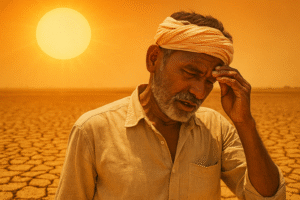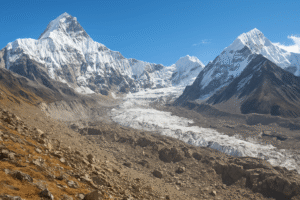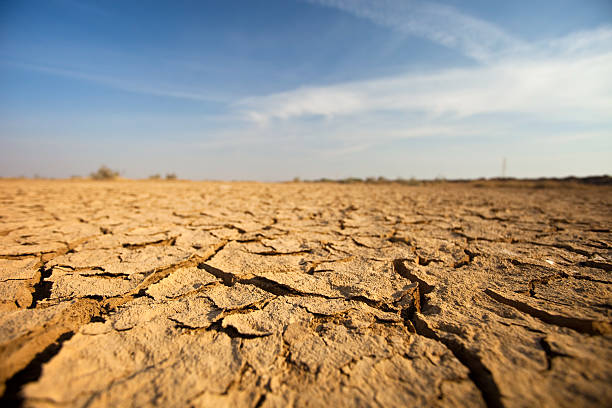How Climate Change Affects India: From Heatwaves to Himalayan Melting
Introduction
Climate change stands as one of the greatest challenges of our time, shaping weather patterns, economies, and the daily lives of billions. Nowhere is this more evident than in India—a nation of over 1.4 billion people, diverse landscapes, and a climate deeply intertwined with the rhythms of the monsoon and the might of the Himalayas. As global temperatures rise and weather becomes increasingly unpredictable, India finds itself on the frontlines, grappling with heatwaves, glacial retreat, erratic rainfall, and the mounting threat to its water, food security, and biodiversity.
Heatwaves in India: Rising Temperatures, Rising Risks

The Growing Threat
India has long been accustomed to scorching summers, but in recent years, heatwaves have grown more frequent, intense, and deadly. The summer of 2024 was a stark example: relentless heatwaves swept across the country, pushing temperatures to record highs and turning cities into furnaces. These extreme events are no longer rare anomalies—they are becoming the new normal, driven by climate change.
Impact on Health
Heatwaves are not just uncomfortable; they are lethal. Exposure to extreme heat can cause heat cramps, exhaustion, heatstroke, and even death—especially among the elderly, children, and those with pre-existing health conditions. Recent studies from cities like Ahmedabad, Hyderabad, and Surat reveal that mortality rates can increase by 20–57% during periods when temperatures soar above 40°C. Hospitals see surges in admissions for heat-related illnesses, and public health systems are stretched to their limits.
The health impacts extend beyond immediate heat stress. High temperatures create favorable conditions for bacterial growth in food and water, leading to outbreaks of diarrheal diseases, cholera, and gastroenteritis. Water scarcity, worsened by heatwaves, further compromises hygiene and increases the risk of infectious diseases.
Impact on Agriculture and Livelihoods
Agriculture, the backbone of India’s economy, is particularly vulnerable. Heatwaves accelerate evaporation, dry out soils, and reduce crop yields. Farmers face the double blow of water scarcity and heat-stressed crops, leading to lower productivity and income. Livestock and dairy animals also suffer—reduced food intake and milk yield have been widely reported.
Anecdotal evidence from villages like Shirsao in Maharashtra highlights the cascading effects: even after adequate rainfall, heatwaves have led to drought-like conditions due to rapid evaporation and declining groundwater. Women in these regions often survive on just one liter of saline water a day, resulting in kidney stones and other health issues.
Impact on Daily Life
Heatwaves disrupt daily routines, strain electricity grids due to increased demand for cooling, and force schools and businesses to close. Urban areas, with their “heat island” effect, become particularly inhospitable, affecting the quality of life for millions.
2025: A Year of Anomalies
Interestingly, May 2025 bucked the recent trend. Instead of relentless heat, India experienced one of its coolest Mays in nearly a century, thanks to an early monsoon onset and unusually high rainfall. Central India recorded its third-lowest maximum temperature since 1901. While this brought temporary relief, experts caution that such abrupt shifts are themselves a sign of climate instability, not a reversal of global warming. The contrast between 2024’s heatwaves and 2025’s cool May underscores the increasing unpredictability of India’s climate.
Himalayan Melting: The Vanishing Water Towers

The Melting Glaciers
The Himalayas, often called the “water towers of Asia,” are home to thousands of glaciers that feed the Ganges, Brahmaputra, and Indus rivers—lifelines for nearly two billion people downstream. However, these glaciers are melting at unprecedented rates due to rising global temperatures.
Scientists warn that glaciers in the Hindu Kush Himalayas could lose up to 75% of their volume by the end of this century if current warming trends continue. Data from ISRO (Indian Space Research Organisation) shows that over 27% of Himalayan glacial lakes have significantly expanded since 1984, with 676 lakes in India alone showing notable growth. This expansion increases the risk of glacial lake outburst floods (GLOFs), which can devastate downstream communities.
Implications for Water Resources
The melting of Himalayan glaciers has far-reaching consequences:
Water Availability: Initially, increased melting leads to higher river flows, raising the risk of floods and landslides. Over time, as glaciers shrink, river flows will decrease, threatening water supplies for drinking, irrigation, and hydropower.
Agriculture: Reduced water availability impacts irrigation, leading to lower crop yields and threatening food security.
Hydropower: Many of India’s dams and hydropower projects depend on consistent glacial melt. Unpredictable water flows challenge energy planning and infrastructure.
Socio-Economic Development: The livelihoods of millions in the Ganga-Brahmaputra-Meghna basin—home to over 700 million people—are at stake.
Impact on Local Ecosystems
Glacial retreat disrupts fragile mountain ecosystems, alters riverine habitats, and increases the frequency of natural disasters such as flash floods and landslides. The changing landscape threatens unique Himalayan flora and fauna, some of which are already endangered.
The Global Context
The urgency is underscored by the United Nations declaring 2025 the ‘International Year of Glacier Preservation’. With global temperatures breaching the 1.5°C threshold above pre-industrial levels for the first time in 2024, the window for meaningful action is rapidly closing.
Other Effects: Monsoon Variability, Rising Seas, and Biodiversity Loss
Monsoon Variability
The Indian monsoon, which delivers 70% of the country’s annual rainfall, is becoming increasingly erratic. Recent years have seen both devastating floods and crippling droughts, sometimes in the same season. The early onset and intensified rainfall of the 2025 monsoon, while cooling temperatures, also brought unusually high thunderstorm activity and disrupted agricultural cycles.
Climate models project that monsoon rainfall could increase by 4–25% in the coming decades, but its distribution will be less predictable, with more frequent extreme events. This unpredictability complicates water management, crop planning, and disaster preparedness.
Rising Sea Levels
India’s long coastline is vulnerable to rising sea levels, which threaten to inundate low-lying areas, erode beaches, and displace coastal communities. Saltwater intrusion affects agriculture and drinking water supplies, particularly in states like West Bengal, Odisha, and Gujarat.
Biodiversity Loss
Climate change accelerates habitat loss and species extinction. Shifts in temperature and rainfall patterns disrupt ecosystems, endangering iconic species such as the Bengal tiger, one-horned rhinoceros, and Himalayan snow leopard. Coral reefs in the Andaman and Nicobar Islands are bleaching, and mangroves in the Sundarbans are under threat from rising seas and cyclones.
Recent Developments: Research, Policy, and Community Action
Research and Monitoring
India’s scientific community is actively monitoring climate impacts. ISRO’s satellite data on glacial lakes and the Indian Meteorological Department’s improved forecasting are helping policymakers and communities prepare for extreme events .
Policy Initiatives
India’s climate action is being recognized globally. In the Climate Change Performance Index (CCPI) 2025, India ranked 10th among 63 countries, thanks to its low per-capita emissions, energy efficiency improvements, and ambitious solar power targets. The nation’s leadership in the International Solar Alliance and its push for electric mobility are notable achievements.
However, challenges remain. India’s continued reliance on coal and delays in policy execution have been cited as drawbacks. The government is working to accelerate renewable energy adoption, phase out coal, and strengthen climate policy enforcement.
Community Initiatives
Across India, communities are adapting in innovative ways:
Water Management: Villages are reviving traditional water harvesting systems, building check dams, and promoting rainwater harvesting to cope with water scarcity.
Climate-Resilient Agriculture: Farmers are adopting drought-resistant crops, changing sowing dates, and using climate-smart techniques.
Urban Planning: Cities are investing in green spaces, heat action plans, and disaster preparedness to protect residents from extreme weather.
A case in point is the experience of women agricultural workers in Maharashtra’s Shirsao village, who are navigating water scarcity and health challenges by organizing for better water management and advocating for government support.
Conclusion
Climate change is reshaping India in profound and unpredictable ways—from deadly heatwaves and Himalayan glacier melt to erratic monsoons and vanishing biodiversity. The events of 2024 and 2025 illustrate both the severity and the volatility of the crisis: one year brings record-breaking heat, the next an unseasonably cool summer, but both are symptoms of a climate system under stress.
India’s response—through scientific research, policy innovation, and community resilience—offers hope, but the scale of the challenge demands much more. As the world’s population and climate pressures grow, the need for unified, decisive action has never been greater. By accelerating the transition to clean energy, strengthening adaptation strategies, and fostering global cooperation, India can not only safeguard its own future but also lead the way in the global fight against climate change.
The time to act is now—for the Himalayas, for India, and for generations yet to come.




